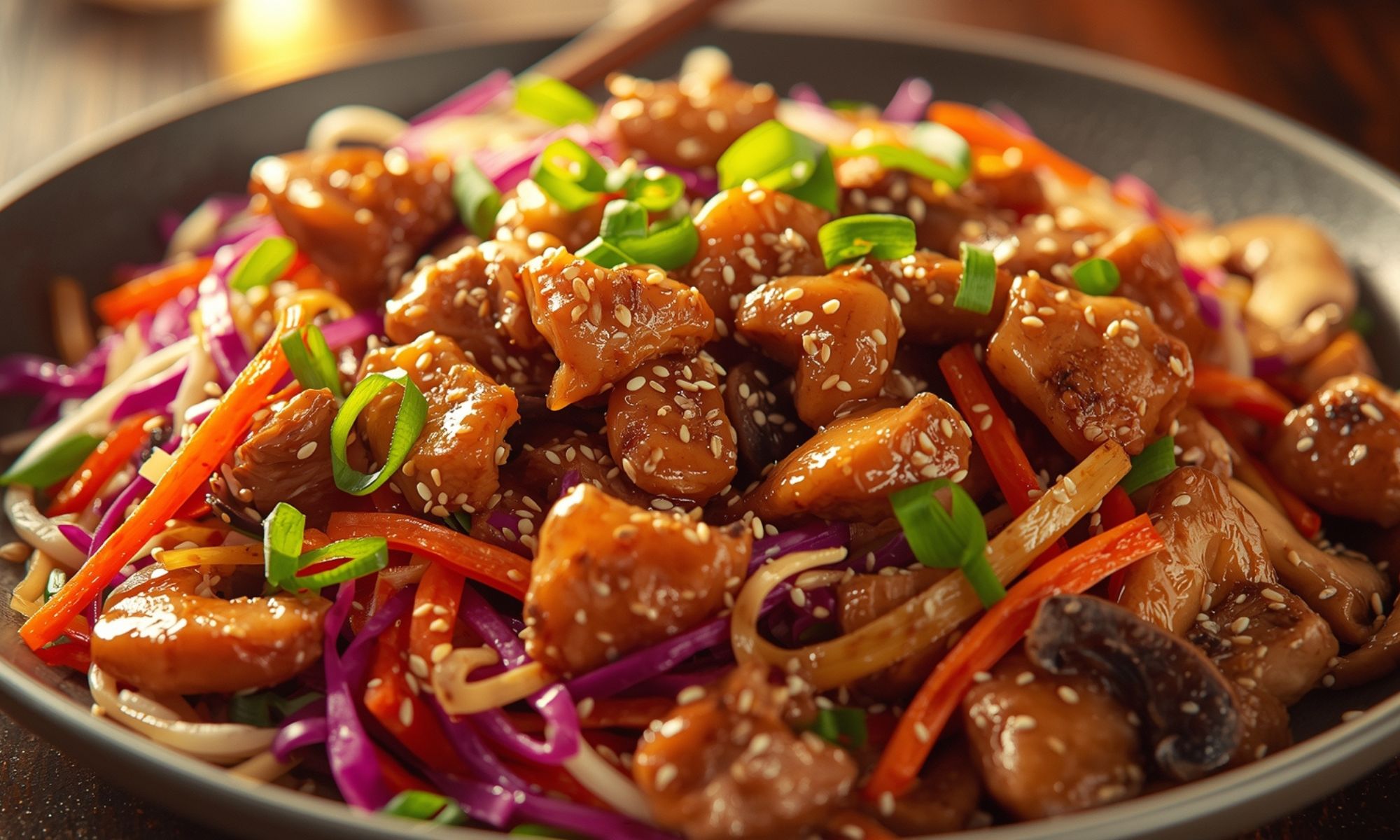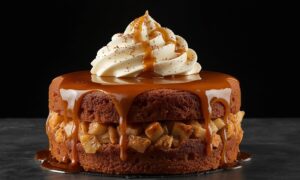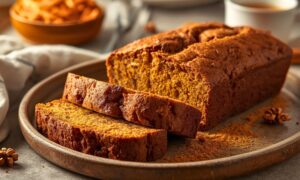The group chat is blowing up, your phone battery’s flashing red, and you’re still staring at a fridge that looks like it lost a fight with last week’s takeout. You’re hungry, impatient, and definitely not in the mood to wait an hour for delivery. That’s when Moo Shu Chicken steps in, fast, flavorful, and way more fun than eating soggy leftovers.
I didn’t plan this recipe like a food stylist with a spotless kitchen. It was a Tuesday night, Wi-Fi cutting out mid zoom, me side eyeing a bag of shredded cabbage and some chicken I almost forgot about. Not a glossy magazine moment, just me, a skillet, and the need to turn chaos into comfort.
The skillet answered back with a hiss. Garlic and ginger hit hot oil like a spark, soy and hoisin turned sticky and bold, and the chicken strips browned into golden, glossy bites. Within minutes, the kitchen smelled like something worth canceling your dinner plans for.
Rolled up in warm tortillas with crisp cabbage and that sweet salty punch, it became the kind of dinner that feels effortless but eats like a small victory. Comfort food, but dressed for the life you’re actually living.
Stick around, I’ll show you exactly how to make Moo Shu Chicken your own, from easy swaps to serving tricks. Once you taste it, you’ll see why this recipe doesn’t just save dinner, it owns it.
What Makes This Moo Shu Chicken Recipe Special

This isn’t your average takeout remake. We’re gonna talk about the real techniques that make restaurant quality results at home. The secret lies in three things: properly velveting the chicken (a technique that’ll change how you cook protein forever), getting your wok screaming hot, and understanding the balance of textures that makes each bite interesting.
The beauty of Moo Shu Chicken is in its versatility. It’s fancy enough for guests but simple enough for a weeknight. Kids love the interactive element of rolling their own wraps, and adults appreciate the complex flavors that develop when everything comes together just right.
Ingredients & Smart Swaps
For the Chicken:
- 1 pound boneless, skinless chicken thighs, sliced thin
- 2 tablespoons cornstarch
- 1 tablespoon soy sauce
- 1 teaspoon rice wine or dry sherry
- 1/2 teaspoon salt
For the Stir Fry:
- 3 large eggs, lightly beaten
- 4 cups cabbage, shredded thin
- 1 cup shiitake mushrooms, sliced
- 1 cup bamboo shoots, julienned
- 4 green onions, cut into 2-inch pieces
- 2 cloves garlic, minced
- 1 tablespoon fresh ginger, minced
- 3 tablespoons vegetable oil (divided)
For the Sauce:
- 3 tablespoons hoisin sauce
- 2 tablespoons soy sauce
- 1 tablespoon rice wine
- 1 teaspoon sesame oil
- 1/2 teaspoon white pepper
To Serve:
- 8-10 Mandarin pancakes (store bought or homemade)
- Extra hoisin sauce for spreading
Now, let’s talk swaps because I know not everyone’s got an Asian market down the street. Can’t find shiitake mushrooms? Regular button mushrooms work fine, though you’ll miss that deep, earthy flavor. No bamboo shoots? Thinly sliced water chestnuts add that satisfying crunch. Living somewhere without rice wine? Dry sherry’s your friend, or even a splash of white wine in a pinch.
Here’s something most recipes won’t tell you: chicken thighs are gonna give you way better results than breasts. They stay tender and juicy even if you accidentally overcook them a bit. But if you’re team chicken breast, just watch your timing like a hawk.
The cabbage choice matters too. Napa cabbage is traditional and has that perfect tender crisp texture, but regular green cabbage works if you slice it super thin. Just don’t use pre shredded coleslaw mix, it’s usually too thick and won’t cook evenly.
Step by Step Magic: Building Your Moo Shu Chicken
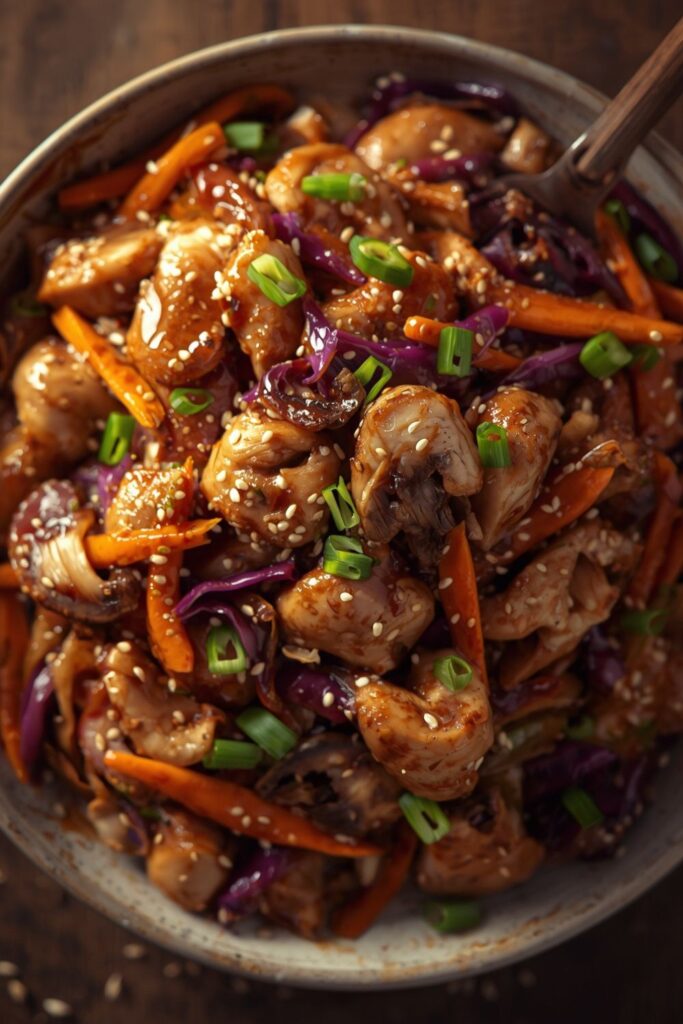
Getting the Chicken Right
First things first, we’re gonna velvet that chicken. This Chinese technique is like insurance for tender meat. Mix your sliced chicken with cornstarch, soy sauce, rice wine, and salt. Let it sit for at least 15 minutes. The cornstarch creates a protective coating that keeps the chicken from drying out, while the soy sauce and rice wine add flavor right into the meat.
Here’s a trick my Chinese cooking teacher taught me: slice the chicken against the grain and keep your knife at a slight angle. You want pieces that are about 1/4 inch thick and maybe 2 inches long. Too thick and they won’t cook evenly. Too thin and they’ll disappear in the stir fry.
The Mise en Place Moment
Before you even think about turning on the heat, get everything prepped and ready to go. Stir frying happens fast, we’re talking 5 minutes from start to finish once that pan gets hot. Have your sauce mixed in a small bowl, your vegetables cut and arranged in the order you’ll use them, and your beaten eggs ready to pour.
This is where good prep shows. Slice that cabbage thin, like coleslaw thin. Cut your mushrooms into uniform pieces so they cook at the same rate. Those green onions? Separate the white parts from the green. The white parts go in first because they need more cooking time.
The Cooking Dance
Heat your wok or largest skillet over medium heat. Add a tablespoon of oil and pour in those beaten eggs. Don’t stir them immediately, let them set for about 30 seconds, then gently scramble them into large, fluffy curds. Remove them from the pan and set aside. This creates those beautiful yellow ribbons that make Moo Shu Chicken so visually appealing.
Now crank that heat to high. Add another tablespoon of oil and let it get shimmery hot. Add your chicken in a single layer, don’t crowd it or it’ll steam instead of sear. Let it sit untouched for about a minute, then stir fry for another 2 minutes until it’s just cooked through. Remove the chicken and set it aside with the eggs.
Building the Vegetable Symphony
Add your last tablespoon of oil to the same pan. Toss in the white parts of the green onions, garlic, and ginger. Stir fry for 30 seconds until fragrant, your kitchen should smell amazing right now. Add the mushrooms and bamboo shoots, cooking for another 2 minutes until the mushrooms start to soften.
Here’s where timing gets crucial. Add that shredded cabbage and stir fry for about 2 minutes. You want it wilted but still with some bite. Cabbage that’s overcooked turns into mush, and nobody wants soggy Moo Shu.
The Grand Finale
Return your chicken and eggs to the pan. Pour that sauce mixture over everything and add the green parts of the scallions. Toss everything together for about a minute until the sauce coats everything evenly and starts to glisten.
Taste and adjust, maybe it needs a pinch more salt or a drizzle more sesame oil. Trust your palate here. The filling should be savory with a hint of sweetness, and every component should still have its own distinct texture.
The Science Behind the Sizzle
What makes stir frying so special isn’t just the high heat, it’s the concept of “wok hei” or breath of the wok. When you cook at extremely high temperatures with constant movement, you’re creating layers of flavor through controlled browning and caramelization.
The velveting technique we used on the chicken works because cornstarch gelatinizes when heated with moisture, creating a protective barrier. This keeps the proteins from contracting too much and squeezing out their juices. It’s basically the difference between rubber chicken and silky, tender bites.
That sauce we made? It’s all about balance. Hoisin sauce brings sweetness and depth, soy sauce adds saltiness and umami, rice wine provides acidity and complexity, and sesame oil gives that final aromatic punch. White pepper instead of black gives a cleaner heat that won’t compete with the other flavors.
The vegetable cooking order matters because different vegetables have different cell structures. Harder vegetables like the white parts of scallions need more time to break down, while delicate greens cook almost instantly. Getting this timing right is what separates good stir fry from great stir fry.
Making It Beautiful & Delicious
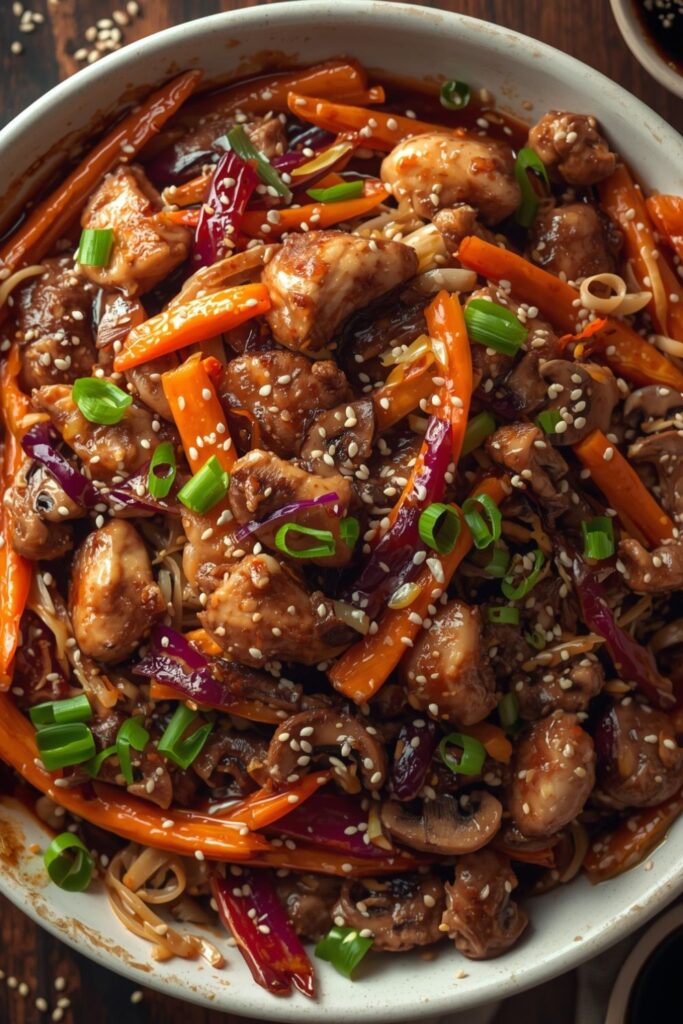
When you’re ready to serve, warm those Mandarin pancakes according to package directions. If you can’t find them, flour tortillas work in a pinch, though they’re thicker and have a different flavor profile.
The traditional way to eat Moo Shu Chicken is to spread a thin layer of hoisin sauce on the pancake, add a generous spoonful of the chicken mixture, and roll it up like a little burrito. Some people like to add extra scallions or cucumber julienne for crunch.
For presentation, arrange everything on separate platters and let people build their own. There’s something communal and fun about this approach that makes dinner feel like an event. If you wanna get fancy, warm the pancakes and keep them in a bamboo steamer or wrap them in a clean kitchen towel to stay soft.
This pairs beautifully with simple steamed rice if you want to stretch the meal, or serve it alongside other Chinese dishes like hot and sour soup or simple steamed broccoli. A crisp white wine like Riesling or even a light beer complements the flavors without competing.
Bringing It All Together
The magic of Moo Shu Chicken lies in how it brings people together around the table. There’s something about building your own little parcels that makes everyone slow down and actually talk to each other. Plus, once you’ve mastered this technique, you can apply it to countless other stir fries.
The most important thing to remember? Don’t stress about perfection. Chinese home cooking is about balance and instinct more than precise measurements. Taste as you go, adjust the seasoning, and trust yourself. Even if your first attempt isn’t restaurant perfect, it’ll still be delicious and way better than takeout.
Keep that wok hot, your ingredients prepped, and your confidence high. This recipe rewards the brave cook who isn’t afraid to let things get a little smoky and exciting in the kitchen.
Frequently Asked Questions
Can I Make Moo Shu Chicken Ahead of Time?
You can prep all your ingredients earlier in the day, but the actual cooking should happen right before serving. The beauty of stir fry is in that fresh, just cooked texture that bursts with vibrant flavors and irresistible aromas. If you absolutely need to make it ahead, undercook the vegetables slightly and reheat everything quickly in a hot pan just before serving.
What If I Can’t Find Mandarin Pancakes?
Flour tortillas work as a substitute, though they’re thicker and have a different flavor that changes the overall bite. You can also make your own pancakes with just flour, water, and a little oil, and the process is easier than you might imagine, even for beginners. Some grocery stores conveniently stock them in the international aisle or frozen section, making it simple to bring this dish together without a special market trip.
My Stir Fry Always Turns Out Watery. What Am I Doing Wrong?
This usually happens when the pan isn’t hot enough or you’re overcrowding it with too many ingredients at once. Make sure your wok or skillet is screaming hot before adding anything, and cook in smaller batches if necessary to keep the heat consistent. Also, don’t add the sauce until the very end, vegetables naturally release water as they cook, and you want that moisture to evaporate completely before introducing any liquid for the best flavor and texture.
Can I Use Different Vegetables?
Absolutely! Bean sprouts, snap peas, bell peppers, or water chestnuts all work beautifully, adding color, crunch, and freshness. Just remember to adjust cooking times based on how long each vegetable needs. Harder vegetables go in first, delicate ones go in last for the perfect stir-fry balance.
How Do I Know When the Chicken Is Properly Cooked?
With the thin slices and high heat, chicken cooks very quickly, usually 2-3 minutes total, developing juicy tenderness. It should look opaque throughout with no pink areas. Since we’re using thighs, there’s more forgiveness than with breasts, but don’t let them get rubbery by overcooking, keep it flavorful, moist, and perfectly cooked.

Swiftly Captions by Tina Smith — Quick, flavorful food recipes made simple, bringing fresh inspiration to your kitchen every day
